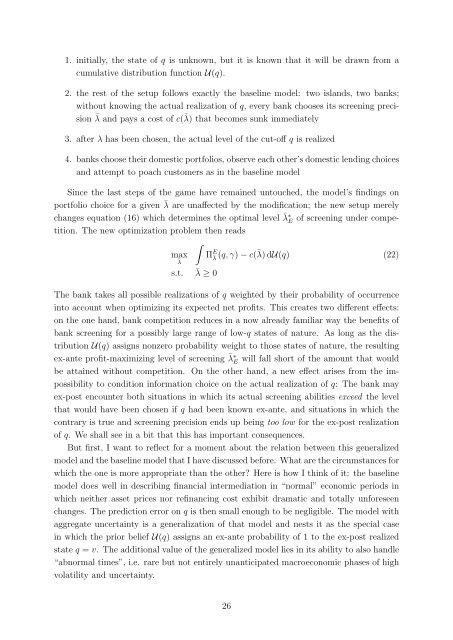Bank Competition, Information Choice and Inefficient Lending Booms
Bank Competition, Information Choice and Inefficient Lending Booms
Bank Competition, Information Choice and Inefficient Lending Booms
You also want an ePaper? Increase the reach of your titles
YUMPU automatically turns print PDFs into web optimized ePapers that Google loves.
1. initially, the state of q is unknown, but it is known that it will be drawn from a<br />
cumulative distribution function U(q).<br />
2. the rest of the setup follows exactly the baseline model: two isl<strong>and</strong>s, two banks;<br />
without knowing the actual realization of q, every bank chooses its screening precision<br />
¯λ <strong>and</strong> pays a cost of c(¯λ) that becomes sunk immediately<br />
3. after λ has been chosen, the actual level of the cut-off q is realized<br />
4. banks choose their domestic portfolios, observe each other’s domestic lending choices<br />
<strong>and</strong> attempt to poach customers as in the baseline model<br />
Since the last steps of the game have remained untouched, the model’s findings on<br />
portfolio choice for a given ¯λ are unaffected by the modification; the new setup merely<br />
changes equation (16) which determines the optimal level ¯λ ∗ E of screening under competition.<br />
The new optimization problem then reads<br />
∫<br />
max Π Ē λ (q, γ) − c(¯λ) dU(q) (22)<br />
¯λ<br />
s.t. ¯λ ≥ 0<br />
The bank takes all possible realizations of q weighted by their probability of occurrence<br />
into account when optimizing its expected net profits. This creates two different effects:<br />
on the one h<strong>and</strong>, bank competition reduces in a now already familiar way the benefits of<br />
bank screening for a possibly large range of low-q states of nature. As long as the distribution<br />
U(q) assigns nonzero probability weight to those states of nature, the resulting<br />
ex-ante profit-maximizing level of screening ¯λ ∗ E will fall short of the amount that would<br />
be attained without competition. On the other h<strong>and</strong>, a new effect arises from the impossibility<br />
to condition information choice on the actual realization of q: The bank may<br />
ex-post encounter both situations in which its actual screening abilities exceed the level<br />
that would have been chosen if q had been known ex-ante, <strong>and</strong> situations in which the<br />
contrary is true <strong>and</strong> screening precision ends up being too low for the ex-post realization<br />
of q. We shall see in a bit that this has important consequences.<br />
But first, I want to reflect for a moment about the relation between this generalized<br />
model <strong>and</strong> the baseline model that I have discussed before. What are the circumstances for<br />
which the one is more appropriate than the other? Here is how I think of it: the baseline<br />
model does well in describing financial intermediation in “normal” economic periods in<br />
which neither asset prices nor refinancing cost exhibit dramatic <strong>and</strong> totally unforeseen<br />
changes. The prediction error on q is then small enough to be negligible. The model with<br />
aggregate uncertainty is a generalization of that model <strong>and</strong> nests it as the special case<br />
in which the prior belief U(q) assigns an ex-ante probability of 1 to the ex-post realized<br />
state q = v. The additional value of the generalized model lies in its ability to also h<strong>and</strong>le<br />
“abnormal times”, i.e. rare but not entirely unanticipated macroeconomic phases of high<br />
volatility <strong>and</strong> uncertainty.<br />
26
















